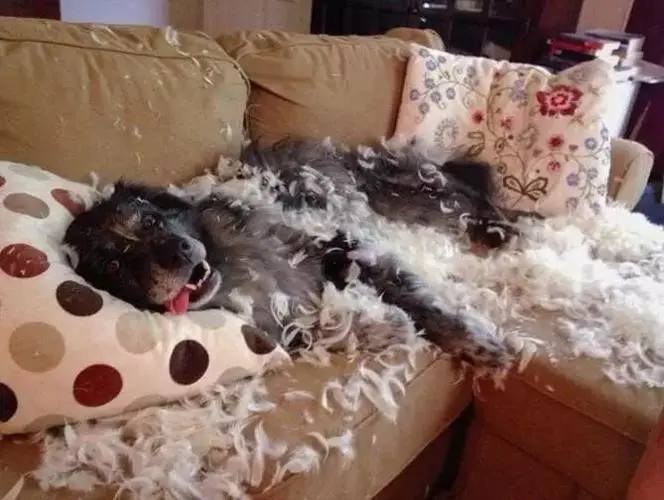Having a dog can bring joy and vibrancy to our lives, but their mischievous habits can also lead to countless troubles. One common issue that dog owners face is destructive chewing. Whether it’s shoes, bed sheets, or soap, if it’s within reach, your dog will likely chew on it. While chewing is a natural behavior, it can lead to dangerous situations if your dog swallows something harmful. So, what can we do to curb this behavior?
Here’s a comprehensive guide to help you manage your dog’s chewing habits effectively.

My Home is a Mess Because My Dog Chews Everything! Effective Solutions to Try
Keywords:
- destructive chewing
- dog chewing solutions
- puppy chewing problems
- training techniques for dogs
- managing dog behavior
- providing safe chew toys
1. Buy Appropriate Chew Toys
Why Chew Toys are Essential
One effective way to combat destructive chewing is to provide your dog with a variety of chew toys. Chewing is a natural instinct, especially during a dog’s teething phase, so it’s best to redirect that urge towards appropriate items.
Recommended Chew Toys
- Rubber Toys: Durable rubber toys can withstand aggressive chewing and are often designed to be filled with treats.
- Dental Chews: These not only satisfy the chewing instinct but also promote dental health.
- Rope Toys: Great for tug-of-war and chewing, these can also help clean your dog’s teeth.
Rotating Toys
To maintain your dog’s interest, regularly rotate the toys. This can prevent boredom and encourage them to engage with the toys rather than your furniture.
2. Use Deterrent Sprays with Unpleasant Odors
Making Items Unappealing
Dogs often chew on items they have developed a particular fondness for. One effective strategy is to use deterrent sprays that emit odors dogs find unpleasant.
Important Considerations
- Non-Toxic Options: Ensure that the deterrent spray you choose is non-toxic. It’s crucial because if your dog does chew on an item sprayed with the solution, you want to avoid any harmful consequences.
Application Tips
Spray the deterrent on furniture and items that your dog tends to chew. Over time, they will learn to associate those items with unpleasant smells, reducing the likelihood of chewing.
3. Address Potential Health Issues
When Chewing May Signal a Problem
Sometimes, excessive chewing may indicate underlying health issues, such as dental pain or anxiety. In rare cases, aggressive behavior could signal a serious condition, including rabies.
Signs to Watch For
- Aggression: If your dog displays aggressive behavior along with excessive chewing, it may be time to consult a veterinarian.
- Physical Symptoms: Watch for other signs of illness, such as lethargy or changes in appetite.
Seeking Veterinary Care
If you suspect your dog has a health issue, do not hesitate to seek professional medical advice. Early intervention can prevent further complications.
4. Implement Training Techniques
Teaching Boundaries
Just like children, dogs need guidance and discipline. Establishing clear boundaries regarding what is acceptable to chew is crucial.
Training Tips
- Consistent Correction: Whenever your dog chews on something inappropriate, use a firm “No” and redirect them to a chew toy.
- Positive Reinforcement: Praise your dog when they choose their toys over other items. This helps reinforce good behavior.
Creating a Routine
Establish a routine that includes playtime with chew toys, reinforcing the idea that these items are the appropriate things to chew on.
5. Consider a Muzzle as a Last Resort
When to Use a Muzzle
If your dog continues to chew destructively despite your best efforts, a muzzle may be a last-resort solution. While it can prevent chewing, it’s essential to use it responsibly and as a temporary measure.
Choosing the Right Muzzle
- Comfort and Fit: Ensure the muzzle fits comfortably and allows for panting and drinking.
- Supervision: Always supervise your dog while they are wearing a muzzle to prevent distress.
Ethical Considerations
While using a muzzle can prevent chewing, it’s crucial to continue working on behavioral training and not rely on it as a permanent solution.
Conclusion
Dealing with a dog that chews everything can be challenging, but understanding the reasons behind this behavior and implementing effective strategies can significantly improve the situation. Providing appropriate chew toys, using deterrent sprays, training consistently, and seeking veterinary care when needed are all essential steps. Remember, early intervention and prevention are key. With patience and dedication, you can help your furry friend learn to channel their chewing instincts appropriately.

Comments (0)